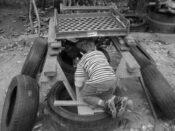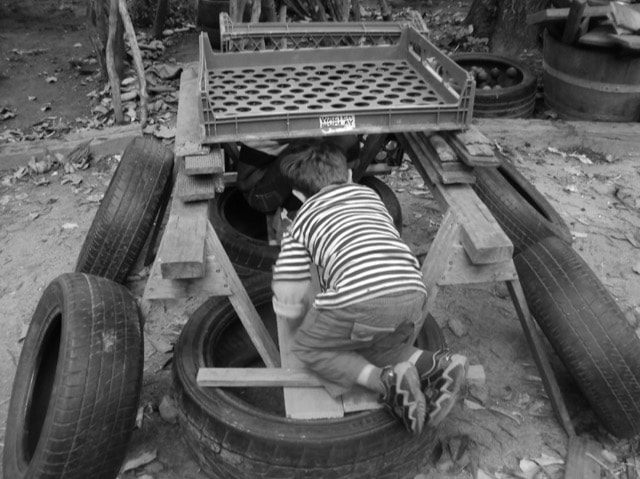Waldorf News
Children’s Play and Virtual Reality

by Pennie Brownlee
reality: noun
1. the state of things as they actually exist, as opposed to an idealistic or notional idea of them.
2. the state or quality of having existence or substance.
virtual: adjective
1. almost or nearly as described, but not completely or according to strict definition.
2. not physically existing as such but made by software to appear to do so.
In the olden days
When I was a child I had never heard of the term ‘virtual reality’. Back then virtual reality wasn’t ‘a thing’, those two words hadn’t been married together for common usage even though the first flight simulator was operational in 1929.
The digital revolution
Virtual reality as a ‘thing’ proliferated in the second half of the twentieth century in association with the exponential developments in the computing technology sector. When we think of virtual reality (VR), many of us think of gaming where players ‘play’ in an immersive life-like simulated world.
While this sector of VR is set to expand as the demand for ‘real-life like’ entertainment increases, VR is currently employed in areas as diverse as psychology, medicine, education and manufacturing.1
You can’t unsee anything
Margaret Fuller reminds us, “The mind is a not a highway but a temple. The door should not be carelessly left open.”2
Never having played VR games myself, I can’t say first hand what could possibly enter through the temple door into the mind of the player. Instead, I have to rely on the experience of others.
Canadian law professor, author and filmmaker Joel Bakan opens his book Childhood Under Siege: How big business targets children with an episode out of Grand Theft Auto.3 The scene depicted would not have slipped through the temple door of the majority of young men in any society in any previous age.
Robbing, maiming, murdering, raping, torturing people in real life are all abhorrent acts of violence that fall outside of healthy human behaviour, yet in many VR games these acts are often rewarded by advancing the player to the next level.
Do you see a bit of a problem here? A flight simulator successfully teaches behavioural responses in the trainee; could it be that immersive murder/rape/torture scenes influence the player’s behaviour?
While there will be people who will answer emphatically not, I myself would ask marketing experts for their opinions.
If advertising didn’t influence people’s behaviour do you think corporations would spend so lavishly on advertising? For example, in 2020 Amazon generated $22 billion dollars of advertising revenue in the 12 months up until May 20214, while Google earned $146.92 billion5 in advertising revenue.
The whole premise of marketing is how to get through the temple door and influence people’s worldview and behaviour.6
Back to VR immersive technology
What we do know is that the ‘choreographed’ scenes influence the player’s physiology. In the initial design process, many (if not most) game designers intentionally script events in order to cause physiological reactions in the player.
These spikes in brain activity and the resultant dopamine release are the cause of behavioural addiction.
Gaming addiction is not addiction to an external substance, but to the almost identical hormonal responses by the brain that are triggered by the ‘action’ in the game. Recreation for pleasure is one thing, but addiction? 7, 8, 9
Fake views
By definition, virtual reality is artificial, substitute, imitation, fake, mock, simulated, at least it is in the incarnations we have been discussing. Furthermore, every part of the VR is someone else’s creation, that is, you get to play in the world they have already created.
While there are choices within that created world which the gamer can make, they are still confined within the echo chamber of someone else’s created world.
But what if there were an incarnation of VR that was pleasurable, which triggered almost identical responses in the brain, but without the withdrawal symptoms associated with gaming addiction? It turns out there is, and it is a genetically encoded function of human brain ‘hardware’.
It is the original VR and, as far as anthropologists can ascertain, it is as old as human culture itself. Indeed, culture could never have arisen without it. It is central to all human achievement, individual and collective, for better or for worse.
We call it imaginative play and it is the inspiration and prototype of all VR technology.
Play and the brain
The human child is born when their brain is a quarter of its adult size. As you might expect, a complex evolutionary brain structure that is only 25% of its eventual size cannot run all of the functions of the mature brain.
It takes time (and nurture) to grow the organic ‘hardware’ and ‘operating system’ required to run human ‘software potentials’ such as multiple intelligences and the skills of executive function.
By the end of the child’s third year the brain has grown to between 85% and 90% of its adult size. This incredible rate of growth and development in the infant brain underpins the maxim, ‘the first three years are the most important’.
Biologically dictated shifts at 2 years, 6-7 years, and 10-11 years usher in three additional levels of consciousness, three different electromagnetic frequencies.10, 11
Each shift alters and extends the way in which the child is able to experience and interact in the world.
Simply Drinking
The simple act of drinking illustrates the progression as the child’s brain is able to handle more complexity of function.
The baby practices the suckling-swallowing function in the womb over and over in readiness for the great separation that is birth. Once born, the baby’s survival depends on their ability to suckle and swallow.
It won’t be too many months into their first year when drinking from a glass or a kitchen cup is introduced to the child. At first the adult holds the glass and tips it judiciously while the child sips and swallows.
This is a different skill from the suckling-swallowing skill she perfected in the womb and it will require all or her attention until she masters it.
Before long the child will learn to hold the glass for herself, with both hands, while she drinks. This new drinking behaviour is practiced over and over until it has been integrated into her subconscious as habit. Once a behaviour becomes habit, there is attention to spare.
Remember the intense concentration you needed while learning to drive? Now that driving is a learned habit, you can drive with attention to spare.
Likewise, once the child has mastered drinking from a cup they have attention to spare and it isn’t long before they accomplish a Milestone of the Mind, they pretend to drink. There is nothing in the glass and they know it.
This great mind leap is the beginning of make believe.
By the baby’s second birthday the child’s brain will have grown to 75% of its adult size. Up until now it has operated using delta brainwaves (1-4 Hz), the long slow frequency band of the subconscious mind. Now theta, the brain’s second subconscious frequency comes on stream.
The addition of theta (4-8 Hz) alters everything for the child; theta is the frequency of intuition, daydreaming and the great human gifts of creativity and imagination.
Imagination is the vehicle for transformation, and once the child gets the hang of imagining, anything is possible.
In the child’s mind, imagination can turn an ordinary kitchen cup into a jewel-encrusted golden goblet or a Viking drinking horn in the blink of an eye.
Leaves and sticks
We take it for granted that children ‘turn’ leaves into plates and sticks into cutlery because most of us did it when we were kids. It’s a feat of imagination, an act of creative magic, and it is normal children’s play.
When a child needs a plate to advance her mealtime play, she picks a leaf, gathers two sticks and sets the table in her kitchen under the feijoa bush. Together with Teddy and dolls, she plays in this virtual reality that she has spun out of her imagination.
When the child’s young friend wants to play too, he can only enter by agreeing that the smoothed dirt is the table, the leaves are plates, the sticks are knives and forks, and the acorns are baked beans.
Now two children are living and playing in a shared virtual reality constructed though their imagination, by their brains, and projected into the real world. But it gets better.

A plate of baked beans. Yum.
Not only are two children playing in a reality of their own shared imagining, they can try out roles inside of that reality: Mum, Dad, Baby, Pippi Longstocking, Mama Bear, Max, Elsa … take your pick … and the children will pick a role that has made an impression on their psyche.
That’s a feature of human consciousness, anything that makes and impression seeks expression. It is that expression that is the healing power of play.11, 12, 13, 14, 15
These children, playing within a reality of their own construction, in a role of their own choosing, can play out the internal energies in their being that are seeking equilibrium and completion.
Thousands of years before there were trained play therapists, children played and soothed their fears, healed their hurts, sorted their misunderstandings, and eased their suffering.
And it gets better still
When children play together it takes a lot of brain grunt to turn an ordinary everyday environment into a pirate ship for example.
Each child takes sensory images from their own brain and superimposes them onto the earth mound that is the pirate ship. Everyone agrees that the mound is now a ship, and they decide whether or not their ship is at anchor or sailing the high seas.
Each child chooses a role, or is assigned one. This involves a shipload of skill if more than one person wants to be the captain.
The would-be captains and crew get to hone their communication-negotiation skills before the play can proceed. This working out of rules and roles can be messy, (politics is messy), yet this group-play is an apprenticeship.
The skills learned and rehearsed here are the skills required to take an active part in society: working out how to work in with others, practising cooperation, and cultivating collaboration.
Unless a hapless pirate is about to be ‘fed to the crocodile’, our role is to allow the players time and space work things out for themselves.12, 13
Superheroes
Protagonists in their own story, the pirates have created their own shared-reality within which to play because it meets their needs for where they are at in their physical, emotional, relational, intellectual, social and creative unfolding.
They decide the plot, the pace, and the action, all of which is the ultimate brain workout.
Imagining a reality in your brain, and bringing it into the real three-dimensional world – this is creation expressing itself into the real world.
If we parents and teachers do not understand the profound elegance play has in unfolding the child’s multiple intelligences and talents, we might not be as vigilant against its theft as we ought to be.14, 15
Grand Theft Imagination
If you are on the lookout for theft, be suspicious of the things that take away the need of the child to make sensory images in their own brain. For example, when I say “tree”, your brain responds by calling up an image of a tree. Your brain has to do the work.
But when I say “tsin”, although you have a whole bunch of ‘tree connections’ in your brain, the Navajo word for tree is not connected with any of them so your brain cannot respond. There is nothing for your brain to do.
There isn’t any image processing for your brain to do when you are watching a screen either.
When the voice in the screen says, “the blackbird perched on the railing” (stimulus), the screen shows you the blackbird perched on the railing (response). The stimulus supplies its own response.
We take this stimulus-response function for granted but it is a learned process that not only builds brains, the neural connections it weaves will serve as the foundations for abstract higher learning later on.
Researchers tell us children are spending fewer and fewer hours in real world play, and more and more hours in screen world consumption.12
Screen hours steal play hours precisely because there is nothing for the child to do when watching a screen.
It’s enjoyable sitting and observing someone else’s creation without having to do any thing, it’s easy. It’s entertainment and anthropologists believe that entertainment is likely as old as human culture, certainly it is as old as the story around the fire.
The difference with the story around the fire though is that it required massive brain grunt. Following the story required the audience to make non-stop images in response to the storyteller’s words.
The storyteller’s words are the script, and the listener turns the script into visuals and sensory sensations within their being.
Stimulus and response, it’s a feat of imagination, a magical act.
Play is human nature
If imaginative play is the original virtual reality and the seedbed of all human creativity, what does the VR created by humans offer the organic ‘nature-built’ human child?
Equipped with 21+ senses16, the human child is a super-sensory learning specialist. With a sensory brain-system resulting from eons of research and development, the child is designed for living in a super sensory world as a member of a social species.
The human child’s first great developmental need then is human connection, beginning with the attachment at birth. Emotional and physical nurture, with face-to-face communication, these are the glue of social connection.
If we want to predict how a child will turn out as an adult, Dr John Gottman’s research17 indicates we look at how the child is socially, how well the child gets along with other children.
Playing with friends in their ‘pirate ship’ ticks the box. It offers opportunities for learning to get along with others in a way that playing Minecraft with ‘friends’ cannot because VR lacks the supersensory data the brain requires to build complex gestalts required for social connection.
The second great developmental need is to play in the world.
Playing, moving, running, jumping, exploring, these are co-creative activities. They build the child’s body and brain, and they create the child’s relationships with the earth, the elements, the creatures and plants.
These relationships are the foundation for the child’s sense of belonging and place, their mana whenua, their turangawaewae.
Even though Minecraft advertising calls the program “the most significant sand box you’ll ever set foot in”18, it is not sand, nor a sandbox.
A child who bonds into a wholly imaginary world, instead of their own imaginary world that is grounded in the real world, is akin to one of Peter Pan’s lost boys in Neverland.
Back to the beginning
It is the nature of the child to play.
Eons of play by millions of ancestors evolved us into the modern humans we are today. Every child unfolds the genetically encoded Play-in-the-DNA story when they play.
Their sophisticated brain is relying on play-in-the-real-world in order to unfold their multiple intelligences.
Critically, this evolutionary story is being accidentally excised from children’s lives by the easier option, entertainment. Play isn’t an optional extra, not if we want to raise happy intelligent kids who get along with others.
You and I know how to turn leaves into plates, now let’s turn our imagination to creating ways which ensure our children have more opportunities to engage in their own imaginative play, in their own good time.
In essence, we would be setting up nature reserves for children simply because it is the nature of the child to play in this extraordinary three-dimensional world.
Increasing time and space for spontaneous unstructured play in children’s lives would be a super human feat of imagination.
Pennie Brownlee was the mother of one, grandmother of two, an artist, teacher, workshop facilitator, publisher and a lover of nature and this stunning wee planet. She wrote three practical guidebooks for parents and teachers: Dance with Me in the Heart, Magic Places, and The Sacred Urge to Play. Visit the Pennie Brownlee Foundation to learn more about her work. Many of the articles she wrote are archived there.
References
1. Panjwani, Laura, (2017, August 31) Special focus: Virtual Reality. R & D World https://www.rdworldonline.com/rd-special-focus-virtual-reality/
2. Fuller, Margaret (1844) Summer on the Lakes in 1843 (as cited by Popova, Maria, The Marginalian, 2017 June 5) www.themarginalian.org/2017/07/05/
margaret-fuller-summer-on-the-lakes/
3.Bakan, Joel, (2011) Childhood Under Siege: How Big Business Targets Children. Allen Lane Penguin, Toronto, Canada
4. Graham, Megan, (2021, May 25) Amazon’s ad revenue is now twice as big as Snap, Twitter, Roku and Pinterest combined. CNBC www.cnbc.com/2021/05/25/amazon-ad-revenue-now-twice-as-big-as-snap-twitter-roku-and-pinterest-combined.html
5. Johnson, Joseph, (2021, February 5) Google: annual advertising revenue 2001-2020. Statista www.statista.com/statistics/266249/advertising-revenue-of-google/
6. Barbaro, Adriana & Earp, Jeremy, (2008) Consuming Kids: The Commercialisation of Childhood [Film], Mediaed, USA
7. Alter, Adam, (2017) Irresistible: Why we can’t Stop Checking, Scrolling, Clicking and Watching. Penguin, London UK
8. Kardaras, Nicholas, (2017) Glow Kids: How Screen Addiction Is Hijacking Our Kids, Saint Martin’s Press
9. Aiken, Mary, (2916), The Cyber Effect. John Murray Publishers, London UK
10. Lipton, Bruce, (2002) Nature, Nurture and the Power of Love: The Biology of Conscious Parenting [DVD] Mountain of Love Productions, Santa Cruz USA
11. Pearce, Joseph Chilton, (1992), Evolution’s End: Claiming the Potential of Our Intelligence. Harper, San Francisco, USA
12. Brown, Stuart & Vaughan, Christopher, (2009) Play: How it Shapes the Brain, Opens the Imagination, and Invigorates the Soul. Scribe Carlton North, Australia
13. Jenkinson, Sally, (2001), The Genius of Play: Celebrating the Spirit of Childhood. Hawthorn Press, Stroud UK
14. Brownlee, Pennie, (2015 Revised) Magic Places: The Adults’ Guide to Young Children’s Creative Art Work. NZ Playcentre Publications, Auckland
15. Brownlee, Pennie & Crisp, Kimberley, (2016) The Sacred Urge to Play: Unfolding Your Child’s Intelligence, Imagination, Creativity and Joy for Life. Good Egg Books, Thames, New Zealand, 2016
16. Durie, Bruce, (2005, Jan 26) Senses Special: Doors of Perception. New Scientist www.newscientist.com/article/mg18524841-
600-senses-special-doors-of-perception
17. Gottman, John, (2009) Raising an Emotionally Intelligent Child [Video] The Gottman Institute. https://www.youtube.com/watch?
v=eVDMATVzhTk&t=8s
18. Vareide, Dennis, (2011, Dec 6) Official Fan Minecraft Trailer [Video] www.youtube.com/watch?v=MmB9b5njVbA
 Transforming Voices Worldwide
Transforming Voices Worldwide Everything a Teacher Needs
Everything a Teacher Needs Summer Programs - Culminating Class Trips
Summer Programs - Culminating Class Trips Flexible preparation for your new grade
Flexible preparation for your new grade Full-Time Teacher Education
Full-Time Teacher Education Immersive Academics and Arts
Immersive Academics and Arts The Journey is Everything
The Journey is Everything Train to Teach in Seattle
Train to Teach in Seattle Discovering the Wisdom of Childhood
Discovering the Wisdom of Childhood Waldorf-inspired Homeschool Curriculum
Waldorf-inspired Homeschool Curriculum ~ Ensoul Your World With Color ~
~ Ensoul Your World With Color ~ Roadmap to Literacy Books & Courses
Roadmap to Literacy Books & Courses Space speaks. Its language is movement.
Space speaks. Its language is movement. Quality Education in the Heartland
Quality Education in the Heartland Apply Today: New Cohort Starts Nov. 2025
Apply Today: New Cohort Starts Nov. 2025 Storytelling Skills for Teachers
Storytelling Skills for Teachers The Art of Administration and Leadership
The Art of Administration and Leadership Caring for All Stages of Life
Caring for All Stages of Life Association for a Healing Education
Association for a Healing Education Bringing Love to Learning for a Lifetime
Bringing Love to Learning for a Lifetime Art of Teaching Summer Courses 2025
Art of Teaching Summer Courses 2025 Waldorf EC Training & Intensives in Canada
Waldorf EC Training & Intensives in Canada Jamie York Books, Resources, Workshops
Jamie York Books, Resources, Workshops Grade Level Training in Southern California
Grade Level Training in Southern California Dancing for All Ages
Dancing for All Ages Middle School Science With Roberto Trostli
Middle School Science With Roberto Trostli Bay Area Teacher Training
Bay Area Teacher Training

 RSS Feeds
RSS Feeds